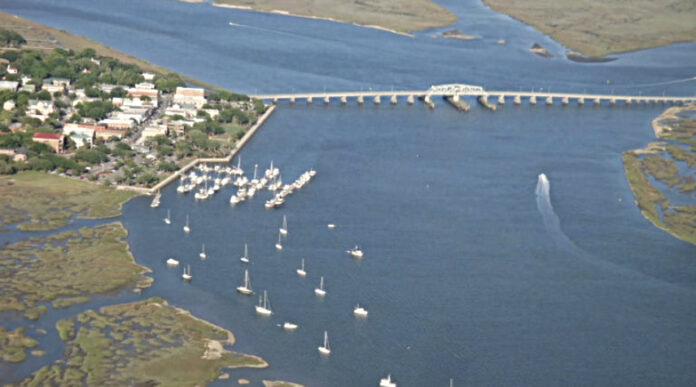Every city has a story to tell, and with over 500 years of history, Beaufort certainly has lots of stories. We dug up 16 fascinating facts about Beaufort SC from the past and present to share with you.
- Let’s start with an easy one: Connecting Beaufort and Port Royal with southern Beaufort and Jasper counties, the Broad River Bridge is 1.7 miles long. They don’t call the river the “broad” for nothing.
- Island Hopping: Did you know that Beaufort is made up of some 68 islands? The Beaufort County Geographic Information Systems Dept. has noted that Beaufort is made up of 68 inhabitable islands and could easily be half water/half land at high tide.
- Oysters, Native Americans and our sea islands– Native American history goes back in excess of 4,000 years on Beaufort’s many sea islands. On Coosaw Island, South Bluff Heritage Preserve is home to what’s left of four ancient Native American oyster shell rings that are around the same age, and was at one time the center of a village. The spots in the middle of the woods are considered to be some of the most complex shell rings in the entire U.S.
- Hollywood Loves Beaufort SC: Hollywood has visited Beaufort quite often over the years with Beaufort’s movie reputation dating back to the 1970s. Fast forward to present day where more than 16 motion pictures and lots of tv productions have been filmed in the Beaufort area, thanks to the beauty, historic appearance and appeal of our little town, and Hollywood’s love affair with it. They include Forrest Gump, The Prince of Tides, The Great Santini, The Jungle Book, GI Jane, Something to Talk About, Stars Fell On Alabama, and many more.
- Beaufort’s been here a minute: Chartered in 1711, Beaufort is the second oldest city in South Carolina, and is over 20 years older than Savannah, Georgia. It was actually discovered before Charleston, but our larger sister city to the north was actually chartered earlier than Beaufort.
- Forrest Gump looks mighty familiar: Did you know that the Woods Memorial Bridge in downtown Beaufort was used in the film as the bridge crossing the Mississippi River during Forrest Gump’s long run across the United States? Along with the bridge, many of the shrimp boat scenes were filmed along Lucy Creek on Lady’s Island and the lagoon area at Hunting Island State Park filled in for the jungles of Vietnam for the film’s war scenes. In addition, the Center for the Arts building on the USCB downtown campus was used as Gump Medical Center. See more locations here.
- Hunting Island State Park was built to help others: Hunting Island was an undeveloped barrier island used for hunting, until the Great Depression came. In the 1930s, the Civilian Conservation Corps hired hundreds of locals to build the new state park, thus giving them all desperately needed jobs in a time of financial crisis. Go deeper into Hunting Island’s history.
- The Beaufort National Cemetery: Created in 1861 during the early area occupation of the Civil War by President Abraham Lincoln, the Beaufort National Cemetery is the final burial site for veterans of every American conflict, up until today. These include the Spanish-American War, World War I, World War II, the Korean War, the Vietnam War, the Gulf War and the conflicts our country has been involved in during the new millennium.
- Hunting Island State Park is most popular: Hunting Island is the most visited State Park in all of South Carolina with over 1 million visitors enjoying its beautiful beaches, maritime forest trails, popular campground and abundant wildlife. The 5,000 acre semitropical barrier island is considered a feather in the cap for tourism in South Carolina.
- The Birthplace of Frogmore Stew: The simple one-pot meal full of everything you love about the Lowcountry was first created by Gullah folk who were enslaved on our sea islands using the simple ingredients that were on hand at the time: Shrimp, Corn, Potatoes, Onions, and pork (sausage). The name Frogmore stew came about in the 1960s when Richard Gay, part owner of the Gay Seafood Company, named it after the little village of Frogmore on St. Helena Island. And, a star was born.
- Cat Island’s naked beginning: Did you know that Cat Island was once a nudist colony? The island was settled in the 1930s as the first nudist colony in the U.S. Although it didn’t last long, maybe about 2 years, it’s still a pretty interesting fact. We’re glad the island’s residents wear clothes today.
- The Hunting Island Lighthouse will get your attention: The lighthouse at Hunting Island was first illuminated on July 1, 1859 and its light, when illuminated, can be seen for about 18 miles from the shoreline.
- Sea Turtles dig our beaches: Thousands of baby loggerhead sea turtles are born every year along Beaufort’s beaches, making our sea islands a vital part of the species’ overall survival.
- The Biggest Historic District you’ve seen: A total of 304 acres of downtown Beaufort SC make up the one single largest designated Historic District in the entire state of South Carolina.
- Seven Flags have flown over Beaufort: With the Beaufort area being discovered by the Spanish and then settled by the British, over time the following flags have flown over Beaufort: Spain, France, Scotland, England, The Confederate States of America, The South Carolina Flag, and The United States Flag.
- Lots of Tabby buildings: Beaufort SC has he largest number of tabby structures in the entire United States, with some dating back to the early 1700s. The Sams Plantation on Dataw Island was built in 1783; Fort Frederick in Port Royal was constructed in 1733 and the Sullivan Tabby Point ruins on Callawassie Island were originally constructed around 1810.











